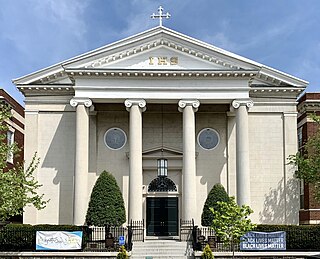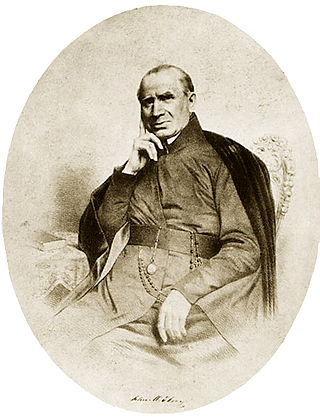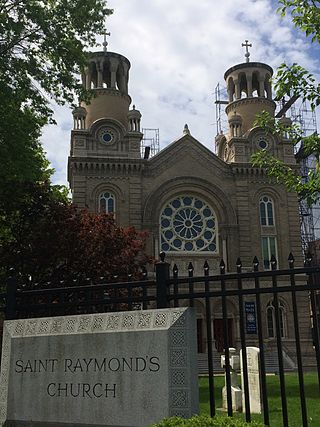
Saint John the Evangelist Catholic Church is a parish of the Roman Catholic Church in Maryland in the United States founded by Fr. John Carroll in 1774. It falls under the jurisdiction of the Archdiocese of Washington and its archbishop. It is named after John the Evangelist.

Holy Trinity Catholic Church is a Catholic church run by the Jesuit order that is located in the Georgetown neighborhood of Washington, D.C., in the United States. Holy Trinity Parish was founded in 1787 and is the oldest Roman Catholic community and house of worship in continuous operation both in Georgetown and in the larger city of Washington, D.C. The original church building was completed in 1794. It is now called the Chapel of St. Ignatius, and is used for smaller ecclesiastical celebrations and as an auxiliary space for parish activities. A larger church building, necessitated by the growing community, was dedicated in 1851, and still serves as the parish church today.

John Dubois was a French-born Catholic prelate who served as Bishop of New York from 1826 until his death in 1842.

Saint John's Catholic Prep is a private, Roman Catholic, coeducational, college preparatory high school in Buckeystown, Maryland, located just southwest of Frederick City. At the time of its founding in 1829, it was located on Second Street in eastern downtown Frederick. Beginning in 1958 and for 45 years thereafter, the school was housed in the historic "Prospect Hall" mansion, (1787–1803), also just southwest of Frederick. St. John's was the first independent Roman Catholic school in the state of Maryland. It was also the first Roman Catholic secondary school in the state of Maryland.

John Mary Joseph Benedict Chanche, S.S., was an American prelate of the Roman Catholic Church. He served as the first bishop Diocese of Natchez in Mississippi from 1841 to 1852.

St. Peter the Apostle Church was a Roman Catholic church located within the Archdiocese of Baltimore in Baltimore, Maryland. Constructed at the northwest corner of Hollins and South Poppleton Streets and, it was often referred to as "The Mother Church of West Baltimore."

John McElroy was a Jesuit priest who founded Catholic schools in the United States. After emigrating to the United States in 1803, McElroy enrolled in Georgetown University in 1806, the same year in which he joined the Society of Jesus as a lay brother. His brother Anthony also became a Jesuit. McElroy assumed the management of Georgetown's financial affairs. He was ordained a priest in 1817. In 1822 he was sent to Frederick, Maryland, where he was to remain for 23 years as pastor of St. John the Evangelist Catholic Church in downtown Frederick. It was in Frederick that he founded St. John's Literary Institution. During the Mexican–American War, McElroy served as an Army chaplain, and on his return from Mexico he went to Boston, where he established Boston College and Boston College High School.

St. James the Less Roman Catholic Church, also known as St. James and St. John's Roman Catholic Church, is a historic Roman Catholic church located at Baltimore, Maryland, United States and was one of the earliest neighborhood parishes established in the central city (1833). The building later became Urban Bible Fellowship Church. On March 29, 2020 lightning struck the steeple, causing the building to catch fire and partially collapse.

St. Mary Roman Catholic Church, formally the Church of the Immaculate Conception of the Blessed Virgin Mary, is in the third oldest Roman Catholic parish in Detroit, Michigan. Designed by German-born Peter Dederichs and built for the formerly ethnic German parish of the 19th century, it is located at 646 Monroe Street in what is now considered the heart of the Greektown Historic District in downtown Detroit. It is often called "Old St. Mary's Church" to avoid confusion with other St. Mary's parishes: in the Redford neighborhood of Detroit, or in nearby Royal Oak, Monroe, or Wayne.

St. Mary's Catholic Church, also known as St. Mary of the Visitation Church, is a parish church of the Diocese of Davenport which is located in Iowa City, Iowa, United States. The church building and rectory were listed together on the National Register of Historic Places in 1980. They were both included as contributing properties in the Jefferson Street Historic District in 2004. The parish's first rectory, which is now a private home, is also listed on the National Register as St. Mary's Rectory. It is located a few blocks to the east of the present church location at 610 E. Jefferson St.

Mitchell Thomas Rozanski is an American Catholic prelate who has served as Archbishop of St. Louis since 2020. He previously served as Bishop of Springfield in Massachusetts from 2014 to 2020 and as an auxiliary bishop of the Archdiocese of Baltimore from 2004 to 2014.

John Carroll was an American Catholic prelate who served as the first Bishop of Baltimore, the first diocese in the new United States. He later became the first Archbishop of Baltimore. Until 1808, Carroll administered the entire U.S. Catholic Church. He was a member of the Society of Jesus until its suppression in 1759.

The Church of All Saints is a parish of the Catholic Church in the Diocese of Davenport. The church is located in Keokuk, Iowa, United States. The church building is listed on the National Register of Historic Places as St. Peter Church, the name of the congregation that built it.

Irvington is a neighborhood in the Southwest District of Baltimore, located between Yale Heights neighborhood to the west and the Gwynns Falls neighborhood to the east. It was historically nicknamed "Skulltown" for its three large cemeteries: Loudon Park, Mount Olivet and New Cathedral.

St. Raymond's Church is a parish church under the authority of the Roman Catholic Archdiocese of New York, located at Castle Hill Avenue at Tremont Avenue, The Bronx, New York City. The parish was established in 1842. It was dedicated on the feast of St. Raymond Nonnatus, on August 31, 1845, thus getting its name. There is a stained glass window, on the right side if you are looking at the sanctuary, of St. Raymond Nonnatus and the men who took him hostage.
The Parish of St. Christopher and St. Sylvia is a parish under the authority of the Roman Catholic Archdiocese of New York, located in Red Hook, Dutchess County, New York. In November 2014, the Archdiocese of New York announced that the parish of St. Sylvia's Church in Tivoli, New York would merge with St. Christopher's. Although it would remain a church which may be used on special occasions, Masses and the sacraments will no longer be celebrated on a regular weekly basis at St. Sylvia's as of August 2015.

The Old Church of St. Peter is a Roman Catholic church established under the authority of the Roman Catholic Archdiocese of New York in Poughkeepsie, Dutchess County, New York in 1837. It is the second oldest Catholic Church on the Hudson and is considered the Mother Church of the Hudson Valley because from it all the parishes in Ulster and Dutchess counties were founded. The church is also referred to as Our Lady of Mount Carmel since 1965 when St. Peter's parish relocated to Hyde Park, New York and the parish of Our Lady of Mount Carmel church relocated to site.
The Church of St. Joachim and St. John the Evangelist is a Roman Catholic parish church under the authority of the Roman Catholic Archdiocese of New York, located in Beacon, Dutchess County, New York. It was established after a parish mergers of the Church of St. Joachim, and St. John the Evangelist. The merged parishes share a pastor, clergy and administrative staff, and the two church buildings continued to be used for worship.

The St. Francis Xavier Cathedral is a historic Catholic church in Vincennes, Indiana, under the Diocese of Evansville. Named for Francis Xavier, the 16th-century Jesuit missionary, it is located opposite George Rogers Clark National Historical Park at 205 Church Street, within the Vincennes Historic District.

Saint John the Evangelist Catholic Church is a Catholic parish of the Archdiocese of Indianapolis in Indianapolis, Indiana, United States. The parish's origins date to 1837, when it was first named Holy Cross parish. In 1850 it was renamed Saint John the Evangelist parish, and is the oldest Catholic parish in the city and in Marion County, Indiana. Considered the mother of the Catholic parishes in Indianapolis, it played an important role in development of the Catholic Church in the city. Saint John's Church served as the pro-cathedral of the diocese from 1878 until 1906; its rectory served as the bishop's residence and chancery from 1878 until 1892. In 1900 the church served as the site of first episcopal consecration held in Indianapolis.























